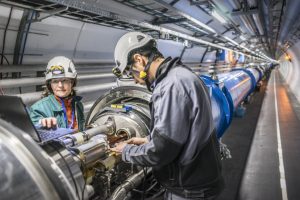The Large Hadron Collider, the world’s largest and most powerful particle accelerator, restarted today after a break of more than three years for maintenance, consolidation and modernization work.
Since Friday afternoon April 22nd at 12:16 hrs, two beams of protons have been circulating in opposite directions around the 27-kilometer ring of the Large Hadron Collider at their injection energy of 450 billion electron volts (450 GeV), CERN announced today.
“These beams circulated at the injection energy and contained a relatively small number of protons. High-intensity, high-energy collisions are still a few months away,” said Rhodri Jones, head of beams at CERN. “But the first beams represent the successful restart of the accelerator after all the hard work of the long shutdown.”
Major upgrade
“The machines and facilities underwent major upgrades during the second long shutdown of CERN’s accelerator complex,” says CERN’s director of accelerators and technology Mike Lamont. “The LHC itself has undergone an extensive consolidation program and will now operate at even higher energy and, thanks to major improvements in the injector complex, deliver significantly more data to the upgraded LHC experiments.”
In October 2021, test beams circulated in the LHC for a short time. However, the bundles circulated today mark not only the end of the second long shutdown for the LHC, but also the beginning of preparations for four years of physical data collection, which is expected to begin in July.
Record energy
Until then, LHC experts will be working around the clock to gradually bring the machine back into operation and safely increase the energy and intensity of the beams before the experiments collide with a record energy of 13.6 trillion electron volts (13.6 TeV).

The ATLAS and CMS experiments can each expect more collisions during this physics run than during the previous two physics runs combined, while the LHCb, which underwent a complete refurbishment during the shutdown, hopes to increase the number of collisions by a factor of three.
Intense beams
Meanwhile, ALICE, a specialized detector for studying collisions between heavy ions, can expect a four- to fivefold increase in the total number of ion collisions it will be able to observe, thanks to the recent completion of a major upgrade.
The unprecedented number of collisions will allow international teams of physicists at CERN and around the world to study the Higgs boson in great detail and to subject the Standard Model of particle physics and its various extensions to the most rigorous tests yet.
New experiments
Other things to look forward to in Run 3 include the operation of two new experiments, FASER and SND@LHC, designed to look for physics beyond the Standard Model; special proton-helium collisions to measure how often the antimatter counterparts of protons are produced in these collisions; and collisions with oxygen ions that will improve physicists’ knowledge of cosmic-ray physics and the quark-gluon plasma, a state of matter that existed shortly after the Big Bang.
(Source: news release CERN)